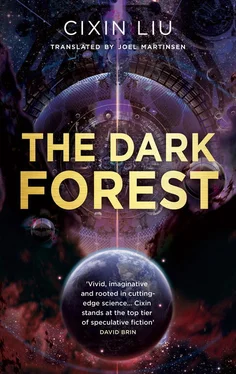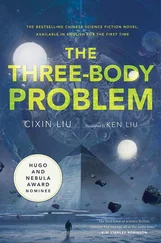Neither computer nor human realized that the explosion had destroyed only Mantis and the four-member expedition team, but not the droplet.
As for the accelerating fragment, the fleet’s space surveillance system issued only a level-three attack alarm, because the approaching object was not a warship and was headed toward one corner of the rectangular formation. On its current heading, it would pass outside the formation and would not strike any warship. Due to the large number of level-one alarms issued following the Mantis explosion, this level-three alarm was completely ignored. The computer had, however, also noted the fragment’s high rate of acceleration. By three hundred kilometers it had already passed the third cosmic velocity and was continuing to gain speed. The alert was upgraded to level two, but was still ignored.
By the time the fragment had flown roughly 1,500 kilometers from the explosion site toward the corner of the formation, only fifty-one seconds had elapsed. By the time it reached the corner, it was traveling at a speed of 31.7 kilometers per second. Now it was on the periphery of the formation, 160 kilometers away from Infinite Frontier, the first warship in this corner of the array. The fragment did not pass by the formation, but executed a thirty-degree turn, and, without slowing down, sped straight toward Infinite Frontier . In the roughly two seconds it took to cover that distance, the computer actually dropped its alert from level two back to level three, concluding that the fragment wasn’t actually a physical object due to the fact that its motion was impossible under aerospace mechanics. At twice the third cosmic velocity, executing a sharp turn without a drop in speed was like slamming into an iron wall. If it was a vessel containing a metal block, the change in direction would have exerted such force as to flatten that metal block into a thin film. So the fragment had to be an illusion.
In that manner, the droplet struck Infinite Frontier at twice the third cosmic velocity, at a heading straight along the first row of the fleet rectangle.
The droplet struck Infinite Frontier in its rear third and passed through with no resistance, as if penetrating a shadow. The extreme speed of the impact meant that two highly regular entry and exit holes roughly the diameter of the droplet’s thickest part appeared in its hull. But no sooner had they appeared than the holes deformed and vanished as the surrounding hull melted under the heat produced by the high-speed impact and the ultrahigh temperature of the droplet’s trailing halo. The part of the ship that had been hit turned red-hot, and the redness spread from the point of impact until it covered half the ship, like a chunk of iron that had just been taken out of the forge.
After passing through Infinite Frontier, the droplet continued onward at a speed of thirty kilometers per second. In the space of three seconds it had crossed ninety kilometers, passing first through Yuanfang, Infinite Frontier ’s neighbor in the first row, and then through Foghorn, Antarctica, and Ultimate, leaving their hulls red-hot, as if the warships were giant lamps lined up.
Then Infinite Frontier exploded. It and the four warships after it were hit in the fusion fuel tanks. But unlike Mantis ’s conventional, high-temperature explosion, this explosion was a fusion reaction triggered in Infinite Frontier ’s fuel. No one ever figured out whether the fusion reaction had been sparked by the droplet’s ultra-high-temperature propulsive halo or some other factor. The fireball of the thermonuclear explosion appeared at the point of impact with the fuel tank and swiftly expanded until it illuminated the entire fleet against the velvety background of space, outshining the Milky Way.
Nuclear fireballs then took shape on Yuanfang, Foghorn, Antarctica, and Ultimate in succession.
In the next eight seconds, the droplet passed through ten more stellar-class warships.
By this point, the expanding nuclear fireball had engulfed the entirety of Infinite Frontier and had begun to shrink, while more fireballs were lighting up and expanding on other ships that had been struck.
The droplet continued to traverse the length of the array, penetrating one stellar-class warship after another at intervals of less than a second.
The fusion fireball on Infinite Frontier had gone out, leaving the ship’s hull totally melted. Now it exploded, spewing a million tons of glowing, dark-red metallic liquid like a bud bursting into bloom, the molten metal scattering unimpeded in an omnidirectional storm of burning metallic magma.
The droplet continued its advance, following a straight line through more warships and leaving a line of ten nuclear fireballs behind it. The entire fleet shone in the flames of these burning small suns as if it had been set ablaze and turned into a sea of light. Behind the line of fireballs, the melted warships continued to fling waves of hot molten metal into space, as if massive rocks were being pitched into a magma sea.
In one minute and eighteen seconds, the droplet had completed a two-thousand-kilometer course, passing through each of the hundred ships in the first row of the combined fleet’s rectangular formation.
By the time the last ship in the row, Adam, was swallowed up in a nuclear fireball, the bursts of metallic magma at the opposite end had scattered, cooled, and spread out, leaving the heart of the explosion—the spot where Infinite Frontier had been a minute before—empty of practically everything. Yuanfang, Foghorn, Antarctica, Ultimate … all of them vanished one after another into metallic magma. When the last nuclear fireball in the line went out and darkness fell upon space once more, the gradually cooling magma that had barely been visible reappeared as dark red lights in the blackness of space, like a two-thousand-kilometer-long river of blood.
After punching through Adam, the droplet flew a short distance of about eighty kilometers through empty space, then executed another sharp turn unexplainable by humanity’s aerospace mechanics. This time the angle it described was even smaller: just fifteen degrees off a total reversal, executed nearly instantaneously even as it maintained a constant speed. Then, after a small heading adjustment that brought it in line with the second row of warships in the fleet’s array—or what was now the first row, in light of the recent destruction—it sped toward the first ship in that row, Ganges, at thirty kilometers per second.
Until this point, Fleet Command had not made any response.
The fleet’s battle information system had faithfully carried out its mission and captured through its massive monitoring network a complete record of all battle information over the course of that one minute and eighteen seconds. The sheer amount of information was for the time being only analyzable by the computerized battlefield decision-making system, which had arrived at the following conclusion: A powerful enemy space force had appeared in the vicinity and had launched an attack on the fleet. However, the computer did not provide any information about that enemy force. Only two things were certain: 1. The enemy space force was located at the position occupied by the droplet, and 2. The force was invisible to every means of detection they possessed.
By this time, fleet commanders were in a state of numb shock. For nearly two centuries, research into space strategy and tactics had dreamed up every possible kind of extreme battle condition, but witnessing a hundred warships blowing up like a string of firecrackers in under a minute was beyond what their minds could comprehend. The tide of information surging out of the battle information system meant that they were forced to rely on the analyses and judgments of the computer battlefield decision-making system and focus their attention on detecting an invisible enemy fleet that didn’t even exist. All battle monitoring capacity was directed into the distant regions of space, ignoring the danger right in front of them. A fair number of people even believed that the powerful invisible enemy might be a third-party alien force distinct from humanity and Trisolaris, because in their subconscious minds, Trisolaris remained the weaker, losing side.
Читать дальше












